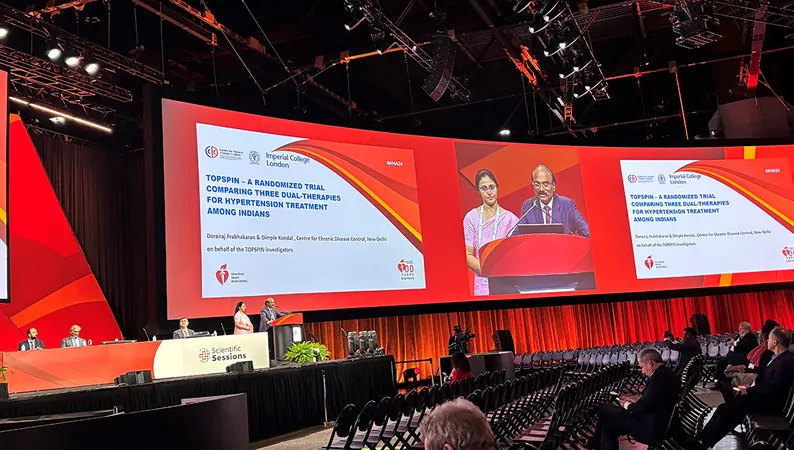
Breakthrough Study Reveals Dual-Combination Pills Effectively Control Hypertension in Indian Patients!
2024-11-22
Author: Wei Ling
In a significant advancement for the treatment of hypertension, the recent TOPSPIN trial has shown that patients in India can effectively manage their high blood pressure with dual-combination therapies administered as single pills. The findings presented at the American Heart Association (AHA) 2024 Scientific Sessions indicate that over 70% of participants were able to reduce their blood pressure to below the target of 140/90 mm Hg.
The study involved 1,981 participants aged between 30 and 79 years, who were either on one antihypertensive medication or not receiving treatment at all. Dr. Dorairaj Prabhakaran and Dr. Dimple Kondal from the Centre for Chronic Disease Control in New Delhi led the research, emphasizing the urgent need for effective hypertension management in a country where approximately 300 million individuals suffer from high blood pressure. Alarmingly, the control rates are only about 7-11% in rural areas and between 11-20% in urban settings.
Traditional clinical guidelines recommend initiating treatment with two antihypertensive drugs from three primary classes: renin-angiotensin-system blockers, calcium channel blockers, and diuretics. Notably, prior to this study, there had been no randomized trial in India specifically evaluating the optimal approach to early dual therapy for hypertension management.
During a press conference, Dr. Shawna D. Nesbitt from UT Southwestern Medical Center cited the staggering increase in hypertension rates worldwide. While Europe and the Americas saw a 41% rise from 1990 to 2019, Southeast Asia experienced a shocking 144% increase in cases during the same period. This highlights the pressing need for localized research and tailored treatment strategies.
Participants in the TOPSPIN trial were randomized to receive one of three single-pill combinations: amlodipine plus perindopril, amlodipine plus indapamide, or perindopril plus indapamide. The results were promising, demonstrating that the mean reduction in 24-hour ambulatory systolic blood pressure at the six-month mark was comparable across all groups, with notable percentages achieving systolic blood pressures below 130/80 mm Hg.
Despite the success of the study, only 2.6% of patients discontinued their medication due to side effects, affirming the overall tolerability of the treatments. Dr. Prabhakaran expressed that these findings align with existing guidelines that suggest flexibility in the choice of antihypertensive agents.
Dr. Nesbitt underscored that the adoption of fixed-dose combinations could enhance patient adherence to therapy, leading to improved outcomes in hypertension management. However, she cautioned that considerations regarding cost and drug availability are essential for the successful implementation of combination therapies in diverse healthcare settings.
In a candid discussion, Dr. Prabhakaran identified key barriers preventing effective hypertension treatment in India, including low public awareness and a lack of screening programs. He noted that many patients remain undiagnosed due to the asymptomatic nature of hypertension and the fear associated with knowing they may require lifelong treatment.
This groundbreaking study not only adds to the understanding of hypertension management in India but also paves the way for future research aimed at tailoring treatment approaches to the unique challenges faced by the Indian population. As the fight against high blood pressure continues, the findings from the TOPSPIN trial are a hopeful beacon for countless patients striving for better health outcomes.



 Brasil (PT)
Brasil (PT)
 Canada (EN)
Canada (EN)
 Chile (ES)
Chile (ES)
 España (ES)
España (ES)
 France (FR)
France (FR)
 Hong Kong (EN)
Hong Kong (EN)
 Italia (IT)
Italia (IT)
 日本 (JA)
日本 (JA)
 Magyarország (HU)
Magyarország (HU)
 Norge (NO)
Norge (NO)
 Polska (PL)
Polska (PL)
 Schweiz (DE)
Schweiz (DE)
 Singapore (EN)
Singapore (EN)
 Sverige (SV)
Sverige (SV)
 Suomi (FI)
Suomi (FI)
 Türkiye (TR)
Türkiye (TR)